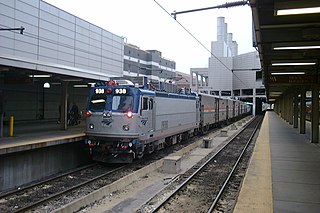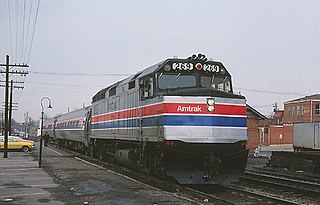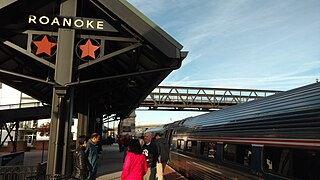
The Capitol Limited is a daily Amtrak train between Washington, D.C., and Chicago, running 764 miles (1,230 km) via Pittsburgh and Cleveland. Service began in 1981 and was named after the Baltimore and Ohio Railroad's Capitol Limited which ended in 1971 upon the formation of Amtrak. It carries the Amtrak train numbers 29 and 30, which were previously assigned to the discontinued National Limited.

The Northeast Regional is an intercity rail service operated by Amtrak in the Northeastern and Mid-Atlantic United States. In the past it has been known as the NortheastDirect, Acela Regional, or Regional. It is Amtrak's busiest route, carrying 8,686,930 passengers in fiscal year (FY) 2018, a 1.4% increase over the 8.57 million passengers in FY 2017. The Northeast Regional service earned over $613.9 million in gross ticket revenue in FY 2016, a 0.4% increase over the $611.7 million earned during FY 2015.

The Pennsylvanian is a 444-mile (715 km) daily daytime Amtrak train running between New York City and Pittsburgh via Philadelphia. The trains travel across the Appalachian Mountains, through Pennsylvania's capital Harrisburg, the Pennsylvania Dutch Country, suburban and central Philadelphia, and New Jersey en route to New York. The entire train ride takes about 9 hours total: 1.5 hours between New York and Philadelphia, 2 hours between Philadelphia and Harrisburg, and 5.5 hours between Harrisburg and Pittsburgh.

The Lake Shore Limited is an overnight passenger train operated by Amtrak between Chicago and the Northeastern United States, with sections to New York City and Boston. The central segment of the route runs along the southern shore of Lake Erie.

The Cardinal is a long-distance passenger train operated by Amtrak between New York Penn Station and Chicago Union Station via Philadelphia, Washington, D.C., Charlottesville, Charleston, Huntington, Cincinnati, and Indianapolis. Along with the Capitol Limited and Lake Shore Limited, it is one of three trains linking the Northeast and Chicago. Its 1,146-mile (1,844 km) trip between New York and Chicago takes 281⁄4 hours.

The Silver Star is a long-distance passenger train operated by Amtrak on a 1,522-mile (2,449 km) route between New York City and Miami via Washington, D.C., Richmond, Virginia, Raleigh, North Carolina, Columbia, South Carolina, Savannah, Georgia, Jacksonville, Florida, and Tampa, Florida. The Silver Star and its sister train in the Silver Service brand, the Silver Meteor, are the descendants of numerous long-distance trains that operated between Florida and New York for most of the 20th century.

The Twilight Shoreliner was a passenger train operated by Amtrak on the Northeast Corridor between Boston, Massachusetts, and Newport News, Virginia, via New York City and Washington, D.C. Amtrak introduced it in 1997 to replace the Night Owl. It was discontinued in 2003 in favor of the Federal.

The Wolverine is a higher-speed passenger train service operated by Amtrak as part of its Michigan Services. The 304-mile (489 km) line provides three daily round-trips between Chicago and Pontiac, Michigan, via Ann Arbor and Detroit. It carries a heritage train name descended from the New York Central.

The Blue Water is a higher-speed passenger train service operated by Amtrak as part of its Michigan Services. The 319-mile (513 km) route runs from Chicago, Illinois, to Port Huron in Michigan's Blue Water Area, for which the train is named. Major stops are in Kalamazoo, Battle Creek, East Lansing, and Flint.

The Hilltopper was a passenger train operated by Amtrak in the Mid-Atlantic region of the United States. It ran daily from South Station in Boston, Massachusetts to Catlettsburg station in Catlettsburg, Kentucky. The 1,674 mi (2,694 km) run made 34 stops in 11 states and the District of Columbia.

The James Whitcomb Riley was a passenger train that operated between Chicago, Illinois, and Cincinnati, Ohio, via Indianapolis, Indiana. Originally operated by the New York Central Railroad, it was taken over by Amtrak in 1971. Under Amtrak, it merged with the Chesapeake & Ohio Railway's George Washington to become a Chicago-Washington/Newport News train. In 1977, it was renamed the Cardinal, which remains in operation.

The Shenandoah was a daily passenger train operated by Amtrak between Washington and Cincinnati from 1976 until 1981.

Petersburg Union Station is a former train station in Petersburg, Virginia, United States. It was built in 1909–1910 for the Norfolk and Western Railway, and was later used by the Atlantic Coast Line Railroad and Amtrak.
The Night Owl was a passenger train operated by Amtrak on the Northeast Corridor between Washington, D.C., and Boston, Massachusetts, via New York City. It operated from 1972 to 1995 on an overnight schedule with sleeper service; it was the only such train on the Northeast Corridor. In 1995 Amtrak dropped most individual train names from its Northeast Corridor services and the Night Owl became another NortheastDirect service, but still on an overnight schedule. Amtrak replaced it with the Twilight Shoreliner in 1997.

Farmville station was an intercity rail station located in Farmville, Virginia. It was served by Norfolk and Western Railway passenger trains until around 1971. It was later served by Amtrak's Mountaineer from 1975 to 1977, then the Hilltopper until 1979. The station building remains extant.

Bedford station was an intercity rail station located in Bedford, Virginia. It was served by Norfolk and Western Railway passenger trains until 1971. It was later served by Amtrak's Mountaineer from 1975 to 1977, then the Hilltopper until 1979. The station building remains extant and is used as a restaurant.

Roanoke station is a train station in Roanoke, Virginia, the current southern terminus of Amtrak's Northeast Regional line. Built in 2017, it follows several other Roanoke passenger stations that operated from the 1850s to 1979. The unstaffed station consists of a single high-level platform with no station building or waiting room available for passengers. All tickets must be purchased in advance; there is no Quik-Trak kiosk at the station.

Christiansburg station was an intercity rail station located in Christiansburg, Virginia. Originally built in 1906 to replace a previous station, it was served by Norfolk and Western Railway passenger trains until 1971. It was later served by Amtrak's Mountaineer from 1975 to 1977, then the Hilltopper until 1979. The station building remains extant.

Catlettsburg is a former Chesapeake and Ohio Railroad station located in downtown Catlettsburg, Kentucky. Opened between 1897 and 1890 to replace an older wooden station, it served trains until 1958. Amtrak trains began stopping at Tri-State Station some 1.5 miles (2.4 km) to the north in 1975; it was renamed Catlettsburg around 1988. Amtrak service was moved from Catlettsburg to Ashland in 1998. The C&O station was refurbished from 2004 to 2006 and added to the National Register of Historic Places in 2012.

The Colonial was an Amtrak intercity passenger train that operated between Boston, Massachusetts, and Newport News, Virginia, from 1976 to 1992. It was introduced on June 15, 1976, to replace the lightly-used Charlottesville-Newport News section of the James Whitcomb Riley. Certain trips were known as the Senator and Tidewater beginning in the late 1970s. The Richmond-New York City Virginian was added in 1984, with some trips called Potomac from 1985 to 1988.





















